Vichyssoise
- 2 large or 3 medium leeks
- 2 large or 3 medium russett potatoes
- 2 Tablespoons butter
- 1 cup half and half
- About 2 cups chicken broth (or more as needed to cover the potatoes)
- salt and freshly ground black pepper
- chopped chives
Clean and slice leeks (see below.)
Melt the butter in a four quart sauce pan and add the sliced leaks. Cook over medium low heat until soft but not brown (about 5 minutes.)
Peel the potatoes and cut into one half inch cubes or slices. Add the potatoes to the sauce pan with the softened leeks. Add enough chicken broth to cover the leeks and potatoes. Bring to a boil, reduce to simmer and cook until the potatoes are fork tender.
Allow leeks and potatoes to cool and then transfer to a blender or food processor. Puree the mixture until smooth (or leave some chunks if you want more of a “country” version.
Transfer to a bowl and add half and half (or a combination of half and half and chicken broth) until soup is desired thickness.
Chill and serve cold garnished with chopped chives.
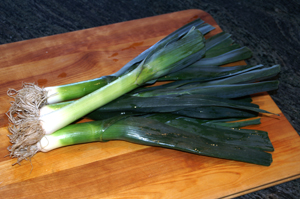
Leeks purchased in the supermarket require cleaning and trimming.
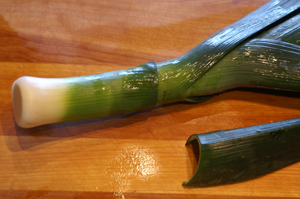
Start by trimming the root end. Then begin trimming the stalks by running a sharp knive around the outer most stalk at the point where the stalk turns from light to dark green.
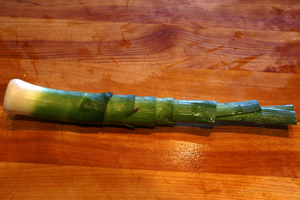
Continue trimming the stalks one layer at a time, preserving the light green tender part of the stalk and removing the dark green tough part.
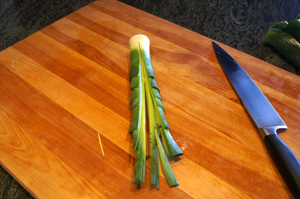
Using a sharp knife and starting an inch from the root end split the leek open.
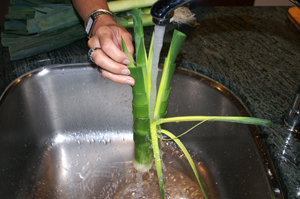
Rinse the leek thoroughly. They are root vegetables and can have dirt and sand lodged in the stalks.
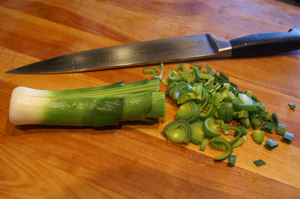
Shake dry and slice across the grain (as pictured) or lengthwise into julienne strips.
- Home
- Recipes
- Hors d'Oeuvres
- Salads
- Vegetables & Sides
- Sauces, Dressings, Dips and Rubs
- Breakfast
- Pasta and Rice
- Soups
- Mains
- Oven Barbeque Brisket
- Chicken Marsala
- Mom's Fried Chicken Wings
- Moules Mariniere
- Steak Tartare
- Corned Beef and Cabbage
- Beef Stew
- Choucroute Garni
- Grilled Shrimp andScallops
- Roasted Chicken
- Braised Short Ribs
- Durbin Dogs
- Singapore Chili Shrimp
- Chicken Fried Steak
- Grilled Sword Fish
- Lamb Shish Kabob
- Pizza
- Diana's Authentic Spanish Paella
- Coq au Vin
- Desserts
Leeks
With a more delicate and sweeter flavor than onions, leeks add a subtle touch to recipes without overpowering the other flavors that are present. Although leeks are available throughout the year they are in season from the fall through the early part of spring when they are at their best.
Leeks are related to onions, shallots and scallions to which they bear a resemblance. They look like large scallions having a very small bulb and a long white cylindrical stalk of superimposed layers that flows into green, tightly wrapped, flat leaves.